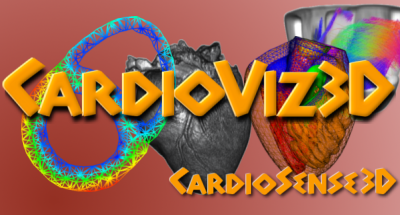
This page includes some movies explaining how to use some of the features available in CardioViz3D.
With CardioViz3D 1.4.0, you can dynamically follow a manually defined landmark in a mesh sequence. For instance in a cardiac dynamic mesh sequence, onwhich you have scalars dynamically attributed to each point, you can follow this specific scalar value in time with the landmark follow-up feature. This tutorial explains how to use it. Note that the landmarks are here manually defined in the 3D view using <
Get the Flash Player to see this player.
This tutorial is an example showing the loading and scalar attribute loading process for the synthetic data available in CardioViz3D sample data .
Get the Flash Player to see this player.
This tutorial shows how to export a movie from a sequence of images or a sequence of meshes. The data used in this example comes from the CardioViz3D sample data . Note that on some linux plateforms, you will have to keep the window clear while writing the movie.
Get the Flash Player to see this player.
This tutorial shows how to crop an image sequence thanks to the region cropping tool. Note that you can at anytime output the image sequence in a image 4D file or a movie.
Get the Flash Player to see this player.
CardioViz3D is able to read and load surface and volume mesh objects. VTK files and .mesh files are supported, as well as all internal Asclepios mesh formats. Scalar fields, vector fields can be assigned to these meshes and visualized. A set of parameters allow the user to manage the visualization of the selected mesh (i.e. Light effects, alpha value, interpolation, scalar field color map, ...). In this tutorial a statistical atlas of the cardiac geometry and fiber directions is read and manipulated
Get the Flash Player to see this player.
One of the most interesting features of CardioViz3D is the full handling of time sequences of data. Sequences can be imported from a set of files, or they can be created directly from a DICOM exam (for the image case). Either single- or multi- topology mesh sequences are handled. The user can also load and assign 4D scalar (or vector) fields to a sequence, and visualize them in real-time. All mesh visualization features are available for sequence of meshes : color and light effects, scalar color maps, projection, cropping, etc.
Get the Flash Player to see this player.
CardioViz3D provides a very intuitive way to generate any surfacic mesh with a few click method. Using implicit function modelling, the process asks the user for a few points (inside/outside or on the surface mesh) and interactively build the surface upon this information. resolution of the final mesh can be set. The mesh can be used and export afterward for any further process.
Get the Flash Player to see this player.